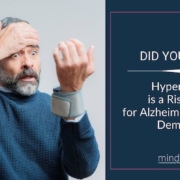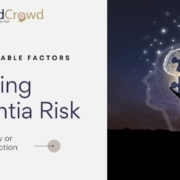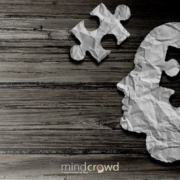Why is There No Cure for Dementia – Yet
If dementia has been around for so many decades, why is there no cure for dementia yet? What are the hurdles that scientists face to find a cure to this devastating class of diseases?
We asked Dr. Matt Huentelman why there is no cure for dementia yet. He shared 7 reasons for it and what it may take to discover the cure or cures or find ways to prevent it.
1. Dementia is Not a Single Disease But Many
Many people believe that dementia is a single illness. It’s important to realize that dementia is an umbrella term. It groups many different types of brain diseases together.
So, to end dementia, scientists must find ways to stop many different brain diseases.
Alzheimer’s is the most common type of dementia. Even though we know beta-amyloid build-up and tau tangle formation are the hallmarks of the disease, we don’t know what causes it.
But you can have dementia caused by other factors too. For example, blood vessel problems within your brain could lead to vascular dementia.
Exposure to different medicines could be the cause of some temporary dementias. So, some medications can actually cause a dementia-like syndrome. Oftentimes, when stopping the medicine, the patient will no longer experience symptoms of the disease.
Lewy Body dementia was discovered in 1912. Parkinson’s was originally considered a neurological syndrome called “shaking palsy”.
Dementia research studies keep discovering different types of diseases that impair brain function as we age. A great example is LATE, a new type of dementia similar to Alzheimer’s that was first described in 2019.
So, dementia is the umbrella term for many types of illnesses and diseases.
It is unlikely, albeit almost impossible, that a single cure will address all of the dementias.

2. In Search of a Cure for Alzheimer’s Dementia: Finding the Cause
When referring to Alzheimer’s research in particular, there have been different hypotheses about its origin or its cause. These different hypotheses or ideas were studied over decades to try to find a cure.
So far, none of them has proven to be the actual cause of the disease. Not knowing the cause, complicates science’s search for a cure.
For example, before 2019:
- 22.3% of the trials focused on the amyloid hypothesis,
- 19% on neurotransmitters as the possible cause;
- about 12.7% of trials tested the tau tangles hypothesis;
- 17% tested the mitochondrial disease of the synapses;
- 7.9% the neurovascular hypothesis;
- 6.6% the exercise hypothesis;
- 4.6% neuroinflammation of the microglia as the cause;
- 0.5% the virus hypothesis;
- and the rest tested a variety of theoretical causes.
Source: PMCID: PMC6799833
For example, some of these trials try to prove that if they can stop the misfolding of or clear the misfolded tau protein, they could slow down or stop the cognitive decline.
What are Misfolded proteins?
A misfolded protein is the result of a normal process that goes wrong inside of a cell.
Every protein in your body, to do its job, has to fold into a three-dimensional shape. And folding happens during a very intricate and specific process inside each cell of your body. When it goes wrong, a protein gets misfolded. These misfolded proteins can cause problems.
Think of it as an origami swan. Every protein starts like a crisp piece of paper and then it has to get folded into a shape to function properly.
And this shape does a certain job. If it gets folded incorrectly, then we can have problems. But every protein starts its life like a regular sheet of paper.
Without a doubt, there is still controversy, and healthy scientific debate about the root cause of Alzheimer’s disease.
How Did these Ideas about the Cause of Alzheimer’s Form and Evolve?
At death – when we examine an Alzheimer’s patient’s brain – we can see very clearly some of the hallmarks of the disease. These include the amyloid plaques, the tau tangles, the loss of brain cells, in that patient’s brain.
Sometimes a patient may receive a diagnosis of Alzheimer’s disease (AD) when living. But at death, when looking under a microscope at that patient’s brain, these particular hallmarks are not present. The patient may have had a different type of dementia.
In general, we know the order in which that happens. Amyloid plaques happen first, followed by tau tangles, followed by cell death. Again, this is in general.
But we still don’t know with certainty what is the cause.
Just because amyloid shows up first in people with Alzheimer’s, it doesn’t mean that amyloid is necessarily the cause. Something else can be happening before amyloid plaques are formed. And we may not be able to see it under the microscope at death. And that could be triggering amyloid plaque formation.
And consider this. The discovery of beta-amyloid buildup in genetic studies of Alzheimer’s disease took place a few decades ago, in 1991.
So much work is being done to understand what might be the true trigger for Alzheimer’s disease. But it is still under debate.
Not Knowing the Cause is a Block to Finding the Cure
Because the cause is not known, it’s much harder to find the cure.
There tends to be much more advancement at developing cures for diseases where the cause is well-known.
That’s why understanding the cause of Alzheimer’s disease and other dementias is fundamental. Because knowing the cause will improve our ability to cure it, prevent it or stop it.
And there could be many different causes, as I believe that not all Alzheimer’s diseases are the same. Besides, we still need to consider how many different types of Alzheimer’s disease there are and may still be.
Let’s Fight Cognitive Decline
We want to find out how to avoid memory loss as we age. Would you like to help?
3. Difficulty Measuring the Disease Progression
We have no way of truly measuring, for example, the speed at which amyloid is deposited or the speed at which tau tangles show up and kill brain cells.
So, it could be that there are multiple types of Alzheimer’s disease based on those different speeds. And someone could have fast-progressing amyloid and slow-progressing tau.
We just don’t know. It’s very difficult to study something when there is no way to measure some of the variables that may lead to different types of Alzheimer’s dementia.
There are still too many question marks, and that complicates finding a cure.

4. Dementias are Largely Slow Progressing
We don’t know for sure, but the best estimates – using the best studies we can do today – suggest that it takes between 15 to 20 years before symptoms start showing. The disease progresses slowly from its very beginning towards memory complaints. That is, when the patient, or their loved ones, notice problems with their memory.
That means for 15, maybe 20 years, there’s no impact on how the person perceives their memory, their cognitive ability.
The disease can go unnoticed for all these years before the first symptom of cognitive decline can be observed in the person’s behavior.
This makes the study even more difficult. Because one thing is if someone gets a fever and you can easily find the virus or the microbe that caused it and the illness is short-lived. Then you would be able to see if you found a cure almost immediately.
As Alzheimer’s is a very slow progressing disease you need very long clinical trials to see if you are changing that trajectory at all.
The slowness of the disease progression adds difficulty to its study and increases the cost of clinical research and trials.
More participants are needed, as some may not develop the disease. They need to be studied for decades, and your cohort may die of different causes as that’s part of life.
5. Diagnostic Accuracy before Death: Alzheimer’s? Parkinson’s? Or Mixed Dementia?
The other aspect is we cannot be 100% certain in any living individual is that they have the textbook definition of Alzheimer’s dementia.
We find many people have mixed types of brain changes at death. For example, we can see Alzheimer’s and Parkinson’s disease changes in the same person’s brain.
Thus, we don’t know with certainty if we have the right people in our studies.
One thing is to study people who are healthy versus people who are not. Then, you can properly define your cohort or study group and the control groups.
But how do we know who is healthy and who isn’t if the memory problems take 15 to 20 years to show?
Neurologists do a very good job at diagnosing dementia in someone who is living with an 80 to 90% accuracy, but it’s not perfect. It’s not one-hundred percent.
There are few trials that try to study anything at the very beginning of the disease. It’s a big complication to finding a cure to Alzheimer’s if memory problems are not evident.
That’s why we are also working on the development of tests that use genetics and other biological markers. Because they can help indicate someone’s risk of developing the disease. And we could use these tests before memory problems start. Even so, these tests are still under development, and they’re not perfect.
But that is part of the promise. To use these tests in healthy people so that we can better predict their risk for Alzheimer’s.
6. Age is the Biggest Risk Factor And We Don’t All Age the Same
Another aspect that happens with all types of human research complicates things. Environmental factors, lifestyle choices, previous medical conditions and illnesses are hard to control.
And they tend to be a much more significant issue for these clinical trials. Why? Because the number one risk factor for Alzheimer’s disease is age.
Any disease that has age as a significant risk factor will find it very difficult to control for these confounding variables.
We’re talking about a very long lifespan that happened in these people during their healthy years before they started living with Alzheimer’s disease.
And clinical research cannot dispute or support a hypothesis because it happened to 10 or 20 people.
So, we need a very large number of people representing a factor to analyze which one of them could have an impact on dementia development.
This is one of the reasons why MindCrowd wants to have one million participants worldwide. But more on MindCrowd later.

7. Lack of Effective Solutions Makes Finding Cures to Other Dementia Types More Difficult
Can a solution that works for a person with early-onset Alzheimer’s work for another with late-onset Alzheimer’s?
The current belief in the field is that a solution for AD that works for one patient will likely work for most Alzheimer’s patients.
The problem is, we don’t have a very strong solution for even one type of Alzheimer’s patient. There are obviously approved medicines, but they tend to be helpful during a very short period.
Scientists believe that these meds may be not as helpful because they are started too late. That is, when memory problems are already present and evident. One approach is to see if these medicines can have a greater impact if they are given at an early stage in the disease.
In general, we assume that if we can help one type of AD, it will translate and make a difference for other types of Alzheimer’s and, even other types of dementia. We haven’t been able to test that because we don’t have many effective medicines to consider.
I have a feeling that we will find unique subtypes of AD that we don’t yet quite appreciate because we don’t all age the same. Some of those may be easier to solve and some may be more difficult.
Aging is complicated. We don’t all age the same because we are different. We have different genetic makeup, different lifestyle, different diets, different family history, different medical history. So, there is no such thing as one size fits all.
And it’s very difficult to study a process that is 40, 50 years long. This adds to the complexity of finding a cure for dementia.

Why MindCrowd Needs 1 Million People to Participate in the Clinical Research
MindCrowd is not a clinical trial. It is research to find ways to slow down this disease via early intervention and a precision aging approach.
We want to do a large study to make sure we are able to capture, understand and examine all of the beautiful diversity that exists in the human population.
MindCrowd is different because anyone 18 and over can join us. We want to cover the entire adult aging spectrum. And we’re looking for all types of people.
This includes people’s genetic makeup. And it also includes their lifestyle factors, medical issues or other things that have happened to them during life.
We need a large study group to better include all these different factors. Then, we can find the people who perform the best, those who do the worst and the ones in the middle. And discover what are the differences between them.
MindCrowd could give us the clue about what may be “the” way to solve the puzzle.
By studying a large group, we have a better chance of identifying various subgroups. That is, various types of people whose brain performs extremely well in the long term.
We believe that we can learn something significant by understanding those different performances.
A better understanding of how the brain works as we age can help us discover how to avoid memory loss, cognitive decline and diseases like Alzheimer’s and other dementias via early intervention and precision aging. This, in turn, would improve brain health and quality of life.
Let’s Fight Cognitive Decline
We want to find out how to avoid memory loss as we age. Would you like to help?
Do all Research Studies Focus on Finding a Cure?
No. Clinical research and clinical trials have a very diverse focus. Some are trying to reverse the disease. Others concentrate on finding ways to detect dementia much earlier. And others focus on prevention.
Prevention treatments are very attractive to everybody. To the general public, to medical and healthcare systems and to pharmaceutical companies. Prevention is really exciting because that typically means the outcomes are better. And most people are interested in avoiding disease.

Why is There No Cure for Dementia – Yet: Summary
The reasons why we haven’t cured dementia, particularly Alzheimer’s, is that people are diverse. It’s a disease of aging. It’s a very slow, progressive disease. So it’s very hard for research scientists to test drugs early in the process.
Remember, dementia is a term for many different types of brain disorders and diseases. It is unlikely there will be one single cure for dementia.
The brain is a very unique organ. It fights back very well. It hides the fact that it’s sick for almost 10 or 20 years.
If you break a leg, it’s very obvious you’ve broken your leg. Your bone can hide from you. If you hurt a muscle or you have a liver disease, it’s usually very obvious that these diseases are present. With brain disease it tends to hide and that is another problem.
Diagnostic inaccuracy has been improved to an 80 to 90% accuracy rate. But not to 100% like with other diseases, and it makes it more complicated to study with certainty.
And, we do not know the cause of Alzheimer’s. We don’t know what starts it off. Thus, we don’t know if we’re even studying the right thing to cure it.
It is not a lack of interest from the research professionals, that’s for sure.
FIND OUT MORE ABOUT YOUR BRAIN.
Discover how it compares with others like you in 10 short minutes by playing the free online MindCrowd memory game.
And help scientists find new ways to protect our brains from memory loss as we age.
Stay Tuned for News about Brain Aging and How to Avoid Cognitive Decline.
Matt Huentelman is a neuroscientist and a human genetics researcher. His laboratory studies how the brain ages and explores various ways in which we can prevent brain aging and protect against diseases of the aging brain like Alzheimer’s disease. His lab is based at TGen in Phoenix, Arizona, and he is also the lead scientist for the MindCrowd project.
MindCrowd is an internet based study of the brain that anyone 18 years of age or older can join and it can be found at mindcrowd.org








